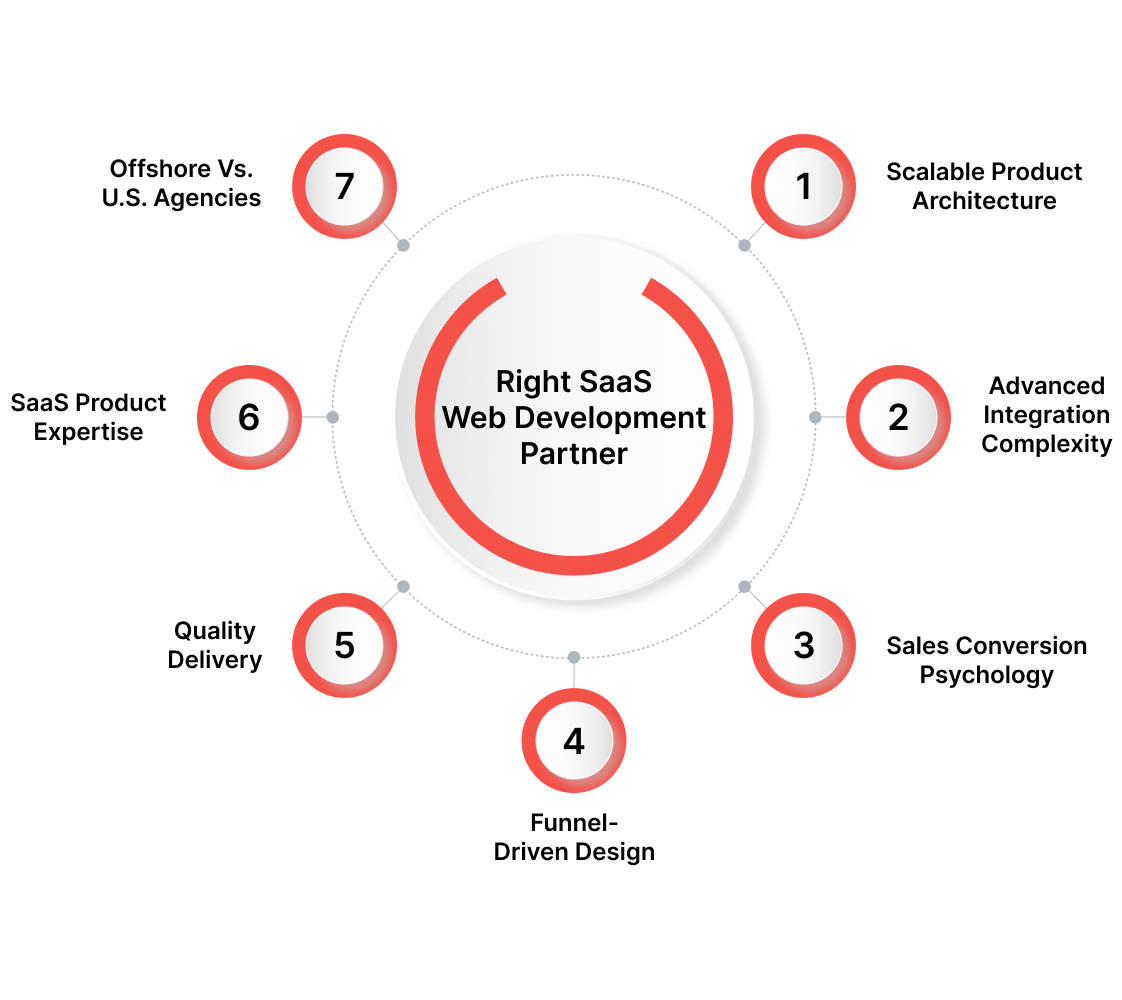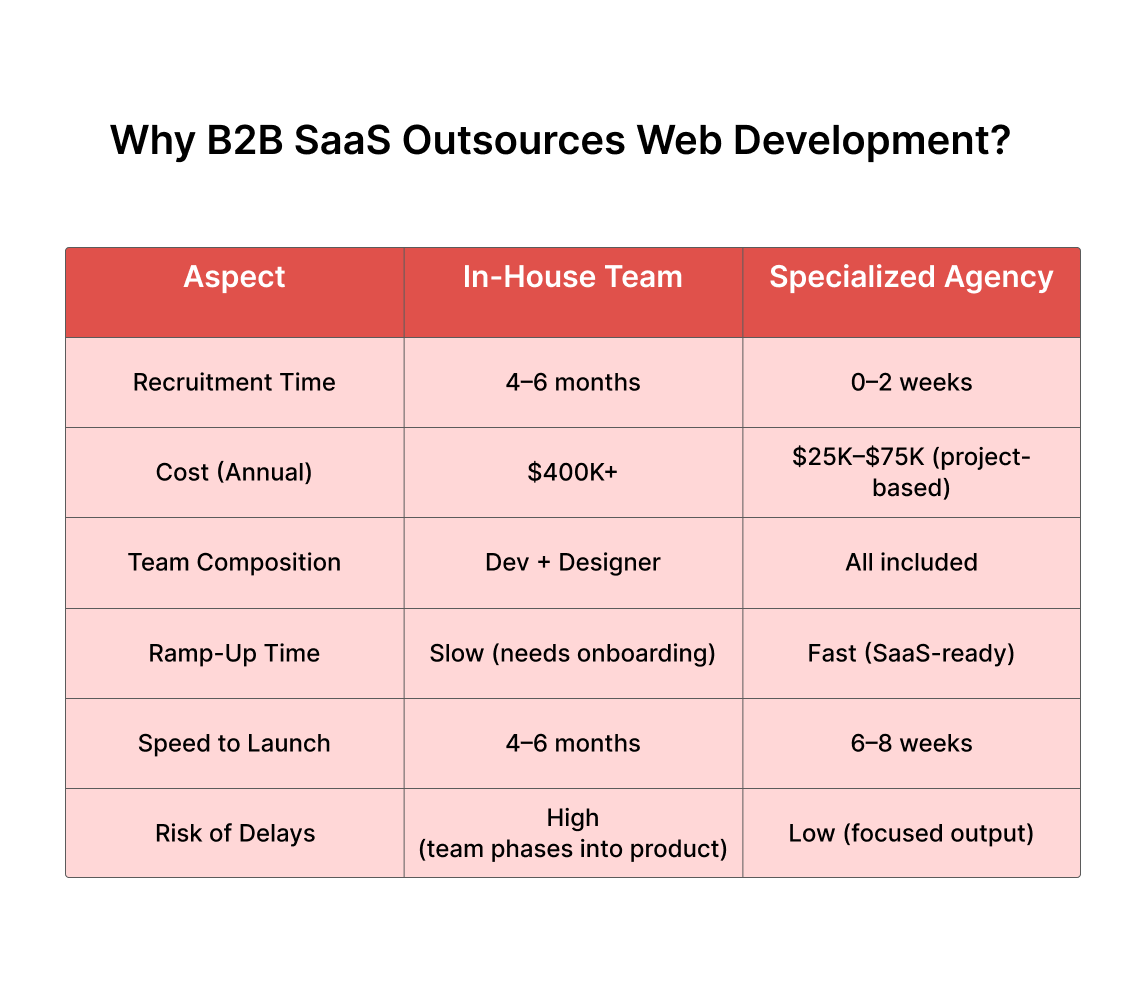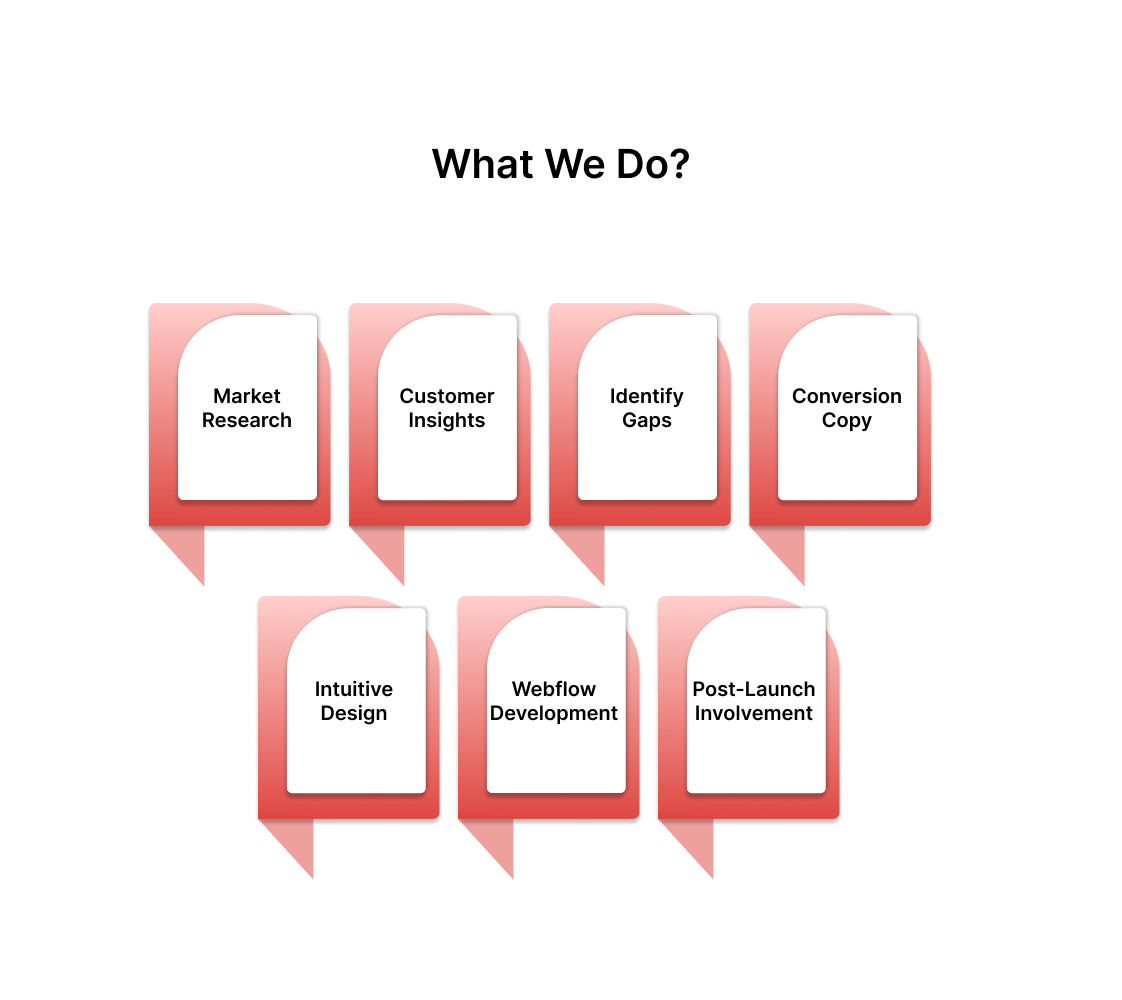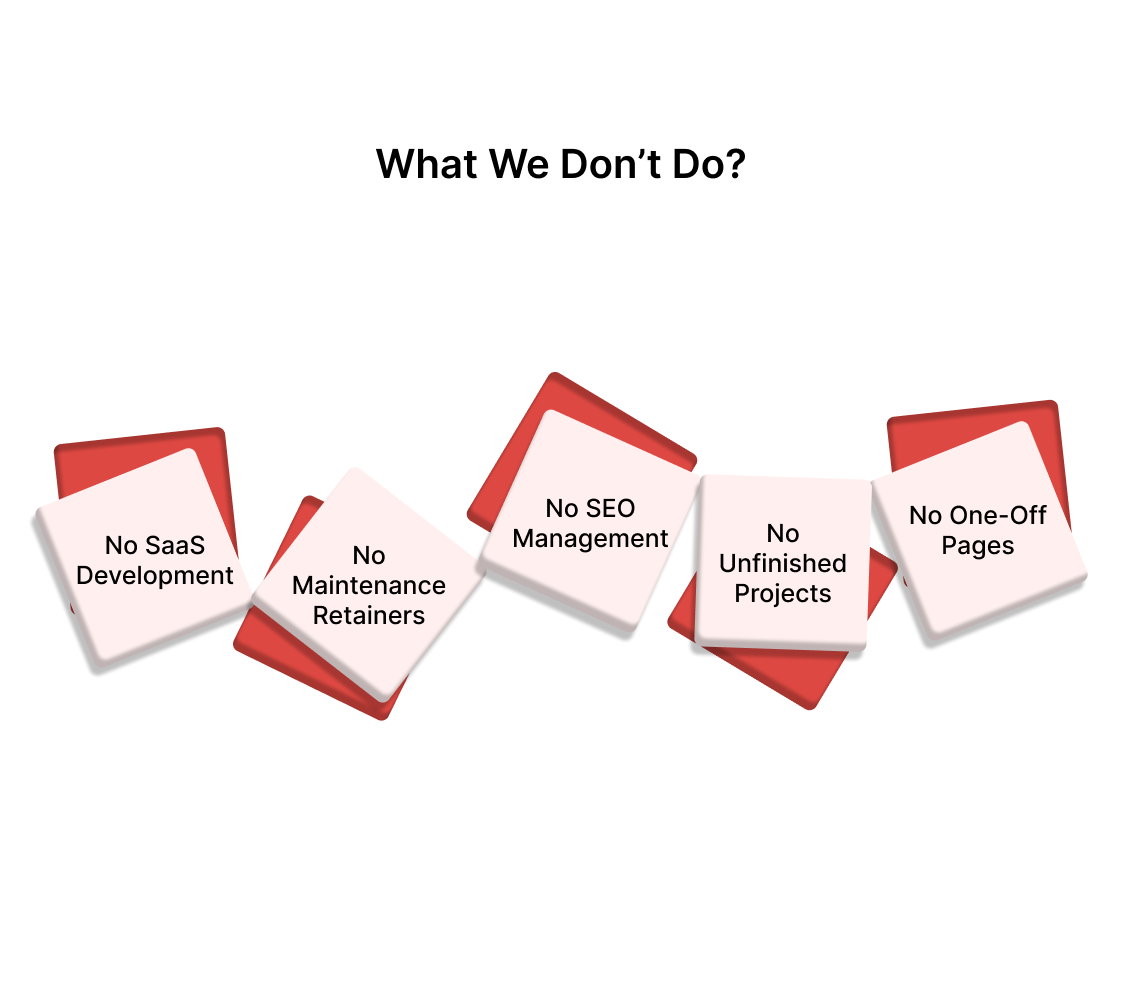What do you do when your SaaS product is gaining traction but your website can't keep up with conversion demands, and you lack the in-house expertise to build something that actually sells?
You panic. Then you realize hiring a full development team would drain six months of runway before they even understand your product positioning.
Or maybe, you act wisely by outsourcing website development to specialists who've already solved these problems dozens of times. Outsourcing isn’t a compromise here. It’s can be the smarter, faster move when done with the right partner. But that’s the catch.
Choosing the wrong company will cost you in tech debt, broken integrations, and lost conversions. SaaS websites need specific technical architecture, integration capabilities, and conversion-focused design thinking that generic web agencies simply don't possess.
So, how do you choose the right website development outsourcing company that “just gets it”?
Before We Dive In:
- SaaS websites require specialized technical architecture: Generalist agencies miss critical requirements like subscription flows, billing integrations, and scalable API connections that affect conversion rates.
- US-based agencies deliver faster results despite higher costs: Communication barriers and timezone delays with offshore teams often extend projects by 2-3 months, negating initial savings.
- Outsourcing beats in-house hiring for speed and expertise: Building an internal team costs $400,000+ annually and takes 4-6 months to ramp up, while specialized agencies deliver in 6-8 weeks.
- Industry exclusivity and limited client capacity indicate quality: Agencies working with 10+ clients monthly or multiple competitors simultaneously can't provide the research depth and market insights your SaaS needs.
This Is How You Find the Right Outsourcing Partner for SaaS Web Development Services

We have seen promising SaaS companies lose 40% of their trial signups because their agency built a gorgeous website that breaks when someone tries to upgrade their plan.
The agency delivered exactly what they promised - a beautiful, fast-loading site. But they had zero experience with subscription flows or billing integrations.
This happens more than you'd think. Agencies show up with impressive portfolios full of restaurant websites and e-commerce stores, then treat your SaaS like just another project.
They don't realize that your biggest conversion killer might be a broken webhook or a form that doesn't sync with your CRM.
1. Technical Architecture That Scales With Your Product
Your website architecture needs to grow alongside your SaaS platform. This means building with APIs that can handle increasing data loads, implementing proper caching strategies, and creating modular components that won't break when you add new features.
Generalist web development agencies build static sites that look good on launch day but crumble under real-world usage. They don't understand how website performance affects trial signup rates or how database queries impact page load times during traffic spikes.
2. Integration Complexity Beyond Basic Plugins
Your SaaS website needs to easily sync with your CRM, billing system, customer support platform, and analytics tools. These integrations are essential for tracking user behavior, automating workflows, and maintaining data consistency across your entire stack.
Most agencies can install a few WordPress plugins and call it integrated. But they struggle with custom API connections, webhook configurations, and the data synchronization challenges that come with complex SaaS ecosystems.
3. Conversion Psychology for Complex Sales Cycles
B2B SaaS sales cycles involve multiple stakeholders, long evaluation periods, and careful ROI calculations. Your website needs content and functionality that addresses different user types at various stages of their buying journey.
Traditional agencies think in terms of single-page conversions. They optimize for immediate actions rather than building trust and providing value throughout extended decision-making processes.
They don't understand how technical documentation, security certifications, and integration guides influence purchasing decisions.
Also read: 2X Your MRR With Conversion Optimization Services for B2B SaaS
4. Design That Supports Your Funnel, Not Just Your Aesthetic
A lot of teams confuse good design with “looks nice.” In SaaS, good design means frictionless onboarding, strong value communication, and smart UX that gets your ICP to take the next step.
The agency needs to understand the anatomy of a high-converting SaaS site, which consists of:
- Hero messaging that maps to your segment
- CTAs that evolve with the buyer’s journey
- Social proof in the right spots, pricing layouts that don’t overwhelm
- And onboarding triggers baked into the flow
Don’t just ask for Figma files. Ask how they test copy, how they prototype flows, and how closely they’ve worked with SaaS marketers before.
5. Speed and Delivery Without Sacrificing Quality
Deadlines matter. You’re launching a new product tier or revamping pricing—your website has to go live before the marketing campaign starts. The right partner will work in sprints, not waterfall timelines.
They won’t promise “done in 4 weeks” and leave you with 27 bugs. Instead, they’ll have a structured kick-off, clear milestones, regular reviews, and enough overlap with your internal comms stack to feel like an extension of your team, not a black box.
Look for a team that uses tools you're already familiar with, such as Slack, Notion, and Linear, and doesn’t make communication a chore.
6. Experience With SaaS Products, Not Just SaaS Clients
There’s a difference between an agency that built a site for a SaaS company and one that understands how SaaS products evolve.
You want a team that can keep pace with your roadmap, understands iterative rollouts, and isn’t thrown off by terms like MRR, onboarding drop-off, or product-led growth. They should be able to look at your existing flow and say, “Here’s what’s missing,” not just “Where’s the design file?”
Check whether they’ve worked with self-serve models, freemium plans, enterprise sales cycles. The closer their past work matches your GTM motion, the better.
7. Location Matters Too: Offshore vs U.S.-Based Agencies
The temptation to hire offshore agencies for cost savings is real. A team in Eastern Europe or Asia can deliver the same technical output for 60-70% less. But here's what the savings calculator doesn't show: the hidden costs of miscommunication, timezone gaps, and cultural misunderstandings.
We have watched SaaS founders spend three months explaining their user onboarding flow to an offshore team, only to receive a website that completely misses the mark. The agency understood the technical requirements but missed the business context entirely.
Working with a U.S.-based agency gives you shared context, faster feedback loops, and deeper alignment on messaging, timelines, and compliance standards. When your SaaS site is tied to product-led growth or tightly integrated with sales ops, that level of clarity is critical.
But have you considered why more B2B SaaS companies are choosing to outsource over building internal teams, even when they have the budget for both?
Why B2B SaaS Companies Are Outsourcing Website Development in 2025

Hiring an in-house dev team to build and maintain your website sounds great in theory until you’re staring at a six-month recruiting timeline and a bloated burn rate.
Even if you do manage to hire a solid front-end engineer and a designer, chances are they’ll get pulled into product tasks within the first two weeks. That’s basically what slows down site launches and kills iteration speed.
- Specialized agencies can deliver production-ready SaaS websites in 6-8 weeks instead of the 4-6 months it takes to hire and ramp up an internal team. They already know which tech stack works best for SaaS sites, which integrations you'll need, and how to structure your information architecture for conversion.
No onboarding from scratch. No waiting for someone to learn what CAC or onboarding drop-off actually means. Just experienced folks who know that a SaaS homepage needs to sell the value prop, not just fill space.
This is especially true during launches, rebrands, or pricing model shifts - moments where marketing velocity matters as much as technical precision. You need a partner who can build fast, without breaking the funnel.
- There’s also the cost angle. Full-time hires are simultaneously expensive and slow to ramp. Then again, cobbling together a freelance team might save money up front, but could lead to mismatched codebases, broken CMS structures, and inconsistent design systems.
Hiring a senior web developer in the US costs between $120,000-$180,000 annually, plus benefits and equity. Then you need a designer, a conversion specialist, and someone who understands SaaS marketing psychology. You're looking at $400,000+ in annual overhead before they write a single line of code.
Compare that to outsourcing a complete website project for $25,000-$75,000 with faster delivery times and no ongoing payroll commitments. The economics make sense, especially when you factor in the opportunity cost of delayed launches.
- Lastly, outsourced teams focused on SaaS website development know how to work in tight feedback loops, build modular systems, and treat every section of the site like a living part of your go-to-market motion. That’s hard to replicate with fragmented internal resources or generic dev shops.
The payoff is a website that ships faster, breaks less, and supports both growth marketing and product evolution. All of these without burning internal capacity or budget on things that should already be solved.
Now you must be rightfully wondering about cost and timeline. While it's not possible to give exact estimates without factoring in your specific requirements, we can share some realistic ballpark figures.
How Much Does SaaS Website Development Cost in 2025?
We won't compare Beetle's pricing and TAT with our competitors. That's a discussion for another day. For now, here's a ballpark estimate of our investment levels. Take these with a grain of salt, as various factors can shift the numbers:
A. Basic Package - $15,000 Ideal for: Early-stage SaaS
- 3 core website pages
- Turnaround: 3-4 weeks
B. Pro Package - $25,000 Ideal for: Growing SaaS
- 5 comprehensive pages
- Turnaround: 4-6 weeks
C. Enterprise Package - $35,000+ Ideal for: Scaling SaaS
- 10+ pages with advanced functionality
- Turnaround: 6-8 weeks
Factors that influence final pricing:
- Custom integration complexity (CRM, billing, analytics)
- Content creation needs beyond standard copywriting
- Advanced animations or interactive elements
- Compliance requirements (SOC2, GDPR documentation)
- Migration from existing platforms with data preservation
Now, allow us to introduce ourselves properly. Don’t worry, this won’t be a sales pitch as we believe in letting our work speak on our behalf.
About Beetle Beetle: What We Do and Who Should Hire Us
We help B2B SaaS companies build high-performing websites that communicate clearly and convert consistently. Every project starts with deep discovery—not just visuals and code.
What We Do:

We don’t jump straight into design. We begin by understanding what’s holding your current site back and what your customers actually need to hear. Here's how we approach it:
- Research your market and competitors
We study your space to see what works, what doesn't, and where you're uniquely positioned. - Understand your customers deeply
Messaging only works when it’s rooted in how your users think, speak, and buy. - Find gaps in your existing site
We assess what’s missing, whether it's clarity, structure, or flow and plan around those. - Write conversion-focused copy
Every word is written to guide visitors toward action, not just fill space. - Design clean, intuitive visuals
Good design supports the story. We focus on clarity, not decoration. - Build the site in Webflow
Fully responsive, modular, scalable - set up for your team to manage with ease. - Stay involved post-launch
We work with you after launch to refine, support, and evolve the site based on real-world use.
What We Don’t Do

To keep things clear, here’s what we don’t offer as part of our services:
❌ We don’t build SaaS products or apps
We don’t design or develop your actual product. That means no dashboards, no onboarding flows inside the app, no feature development, and no web apps.
Our focus is entirely on your marketing site - the site that explains your product and helps convert visitors into paying users.
❌ We don’t do ongoing maintenance retainers
We’re not a long-term dev shop for site tweaks and bug fixes. We’ll support your team post-launch, but we don’t run monthly update retainers for incremental work.
❌ We don’t write blog content or manage SEO
We help structure and build your site for SEO performance but we don’t handle ongoing blog content, content strategy, or technical SEO retainers.
What we do is write clear, customer-focused copy for your core marketing pages, such as the homepage, product pages, pricing, use cases, and more. Copy that explains your product, speaks to your audience, and drives conversions. That’s baked into every project we take on.
❌ We don’t take over unfinished projects
If you already have a half-built site or a dev handoff gone wrong, we’re probably not the right team to pick it up mid-way. We do our best work when we’re involved from day one.
❌ We don’t do one-off landing pages
We don’t just spin up a single landing page unless it's part of a larger site revamp or system. If you’re looking for quick-fix CRO experiments, a growth team or performance agency might be a better fit.
Who We Work With
We keep our work focused and intentional. That means taking on:
- Only 2 new clients per month
Each project is research-heavy and hands-on, so we limit how many we do at once. - No industry overlap
We don’t work with direct competitors to keep your edge sharp.
You’ll Be a Good Fit If You Have:
- A product your customers genuinely love
- $30K+ in MRR or have raised funding
- ARPU of at least $100/month or $12K annually
- A B2B audience with a clear problem to solve
- A strong desire to grow with a long-term view
- The time and bandwidth to invest in doing it right
We're not a match for everyone, and that's fine. But if this sounds like where you're headed, we're always open to a conversation.
Book an intro call today to see if we’re a good fit.
FAQs
1. What’s the difference between a SaaS marketing website and a regular business website?
A SaaS marketing site is built to explain a complex product clearly, convert high-intent visitors, and support sales and onboarding. It needs stronger messaging, smarter UX, and tighter integration with tools like CRMs and analytics platforms.
2. Can Beetle Beetle build a Webflow site for an early-stage SaaS startup?
Yes. If your product has traction, real users, and you're ready to invest in growth. We work best with startups that are past MVP and need their site to keep pace with the business.
3. Do you offer both SaaS website design and development services?
Yes. Every project includes strategy, copywriting, design, and full Webflow development. We don’t split those into separate services because they’re too tightly connected to do in isolation.
4. How long does it take to build a B2B SaaS website with Beetle Beetle?
Most projects take 6–8 weeks from kickoff to launch. That includes research, copy, design, development, and handoff. Timelines stay tight because we only take on two clients at a time.


.jpg)





























